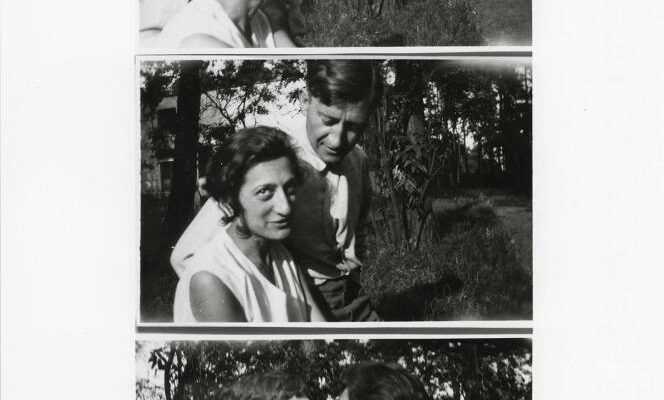She breathed new life into the ancestral practice of tapestry. He signed Tribute to the square, one of the iconic works of post-war abstraction that paved the way for optical art. A fusional couple, Anni and Josef Albers (died in 1994 and 1976 respectively) have never collaborated except to make Easter eggs, but formed a fabulous duo of educators to whom the MAM, in Paris, pays tribute until January 9. Together, they were the figureheads of one of the most beautiful adventures of the XXe century, the Bauhaus, this revolutionary school, of which they were first students before becoming the masters and perpetuating the spirit for more than half a century. With one and only aspiration: to make their life a theater of experimentation.
In 1922, however, when Josef Albers met Annelise Fleischmann, a world separated them. Family of Catholic workers for him, Jewish bourgeoisie of Berlin, converted to Protestantism, for her. “Anni” has just been admitted to the Bauhaus in Weimar, which Josef, eleven years his senior, had joined two years earlier; it’s love at first sight. Founded in 1919 by Walter Gropius, the school wants to reconcile fine and applied arts, crafts and mass production – and also to erase the boundaries between social classes. His precept? The beautiful in the useful, so that art permeates life in all its aspects.
Progressive, the Bauhaus opened its doors wide to women. Alas, he relegates them to the disciplines considered minor and Anni, reluctantly, joins the weaving workshop – which she will end up directing in 1930 -, while following the color courses of her idol, the painter Paul Klee. For his part, Josef excelled in glass painting, of which he quickly became the workshop manager. Both like the intersection of disciplines. Anni imagines furnishing fabrics and theater curtains, while fashioning jewelry. Josef devotes himself, with the same happiness, to furniture and photography. Their practices, although autonomous, are parallel and nevertheless… convergent. Josef’s stained-glass windows are matched by Anni’s geometric hangings. For historian Nicholas Fox Weber, who heads the Josef and Anni Albers Foundation in Connecticut, the couple, who married in 1925, have in common “A colorful art of delicacy and panache”.
When the Bauhaus closed its doors in 1933 at the time of the advent of the Nazis, the couple, like many colleagues, emigrated to the United States. Direction Asheville (North Carolina). Josef soon takes the head of the arts department of Black Mountain College, a free university where he will have as students Robert Rauschenberg, Cy Twombly or John Cage. Anni developed the experimental weaving workshop and enjoyed a monographic exhibition at MoMA in New York in 1949. Far from being eclipsed by her husband, in the 1950s she inspired a new generation of “textile” artists, including Sheila Hicks.
To its American disciples the tandem transmits the precepts of the Bauhaus: the taste for experimentation, the economy of means and tactile learning. Anni repeats it: “You have to let the material show the way. “” Think with your eyes “, hammers on his side Josef, who will later teach at Yale University. Complices in their pedagogy, Anni and Josef are also accomplices in their common passion for pre-Columbian art, which they discover during many trips to Mexico – “Promised land of abstract art”, according to Josef -, in Peru and Guatemala. From Andean cultures, they borrow shapes, patterns and palettes that permeate the serial interlocking of colorful squares by Josef as well as Anni’s weavings. A fruitful dialogue from start to finish.
“Anni and Josef Albers”, until January 9, 2022, Musée d’art moderne de la Ville de Paris. mam-paris.fr
